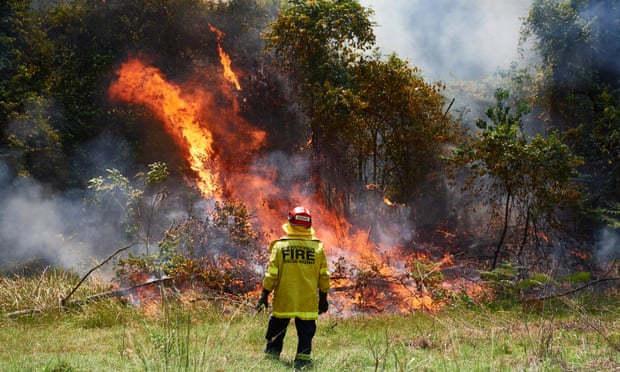Record-breaking spring temperatures helped spark and fan bushfires across the country on Thursday, forecasting a potentially devastating bushfire summer.
In Victoria, 100km/h winds fanned more than 60 blazes, as an unprecedented heatwave moved north to south, drawing comparisons with the “worst conditions you’d see in February or March” from the state’s emergency services minister Lisa Neville.
“This shows us what the risks will be in summer around Victoria, so we still have a long way to go to be ready.”
Neville said emergency services crews were equipped and trained for the difficult forecast summer, but she said she was concerned about residents of bushfire-prone areas being properly prepared.
“One of the things we felt earlier this year out of the fires that happened over the summer was that there was a level of complacency.”
A fire near Yorketown on South Australia’s Yorke Peninsula was sparked by a network power fault, local authorities revealed on Thursday.
The blaze forced the evacuation of towns, destroyed homes and crops, and injured more than 30 people. More than 60 fires burned across the state on Wednesday, fanned by soaring temperatures and high winds.
At least 11 properties had been affected by the fire but the full extent of the losses was still to be determined.
At the height of the emergency, the Yorke Peninsula mayor, Darren Braund, said many residents had taken shelter overnight in the Edithburgh Town Hall but had been told to leave.
“People are very worried, a lot of anxious people, hoping their properties are OK,” Braund told the Adelaide Advertiser.
“There were warnings throughout the night from Country Fire Service, all of a sudden the wind changed. From what I understand, the fire jumped containment lines, that’s when it got very dangerous.”
Victoria’s most extreme bushfire warning – code red – was issued for central and northwestern region, and a fire ban imposed across the state.
Melbourne’s maximum temperature of 40.9C matched the 1894 record for hottest November day. Laverton was the hottest place in Victoria at 44.3 degrees.
In Mildura, a thick haze of red-earth dust blanketed the city – the regular duststorms a consequence of drought – and in the west of Victoria, more than 80,000 homes were left without power after a network failure which also sparked a fire.
A storm which moved across the state caused widespread damage. The state emergency services received more than 1600 calls for assistance, 1300 concerning felled trees.
Fires continue to burn across NSW. Already this season, six people have died in NSW fires, and 612 homes have been destroyed.
The state’s Rural Fire Service said there were currently 59 bush and grass fires burning across the state at 5pm, with 29 still to be contained. Only one fire, at Bora Ridge in the north of the state, is at emergency warning level.
There are no total fire bans in place in NSW for Friday, but there is a high fire danger forecast, and warm weather is set to continue.
The smoke haze which blanketed Sydney much of the day is expected to remain, but will clear overnight and tomorrow morning with a wind change. Forecasters are expecting the smoke to return at the weekend.
The Bureau of Meteorology said a number of locations in South Australia broke November heat records, including Lameroo at 44C, Murray Bridge at 45.3C and Nullarbor at 46.6C.
In Tasmania, Hobart equalled its hottest ever November day, while the statewide top temp of 38.3C at Campania was just 0.2C lower than the November record for any place in the state. Two fires continue to burn in that state.
Cooler conditions heading into Thursday evening were expected to help contain all bushfires still being patrolled by firefighters in Victoria. However, Emergency Victoria encouraged people to stay alert.
A fire near Ballarat that was at emergency level was also downgraded to a “watch and act” warning.
The fire was heading towards Dunac, but water-bombing from helicopters and aircraft helped contain it.
“It was horrific almost, there was branches coming down all over the place, the wind was blowing, it was hot,” farmer Tom Davies said from Dunac.
“For a fire day you wouldn’t have got much worse.”
Davies has lived and worked in the Dunac area all his life, but can’t remember another day like this ever happening so early in the summer.
“No, I don’t think so. For a serious fire like we’ve just had, I think this would be about the earliest I’ve seen it,” he said.
“Generally you don’t get a day like we’ve just had until after Christmas.”








































admin in: How the Muslim Brotherhood betrayed Saudi Arabia?
Great article with insight ...
https://www.viagrapascherfr.com/achat-sildenafil-pfizer-tarif/ in: Cross-region cooperation between anti-terrorism agencies needed
Hello there, just became aware of your blog through Google, and found ...